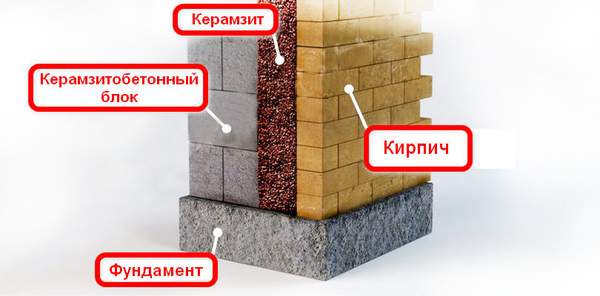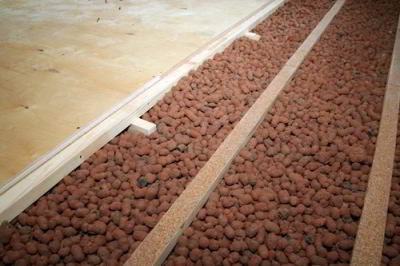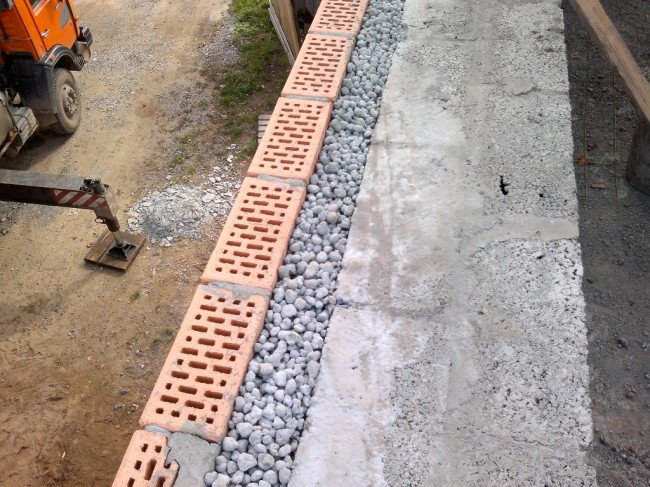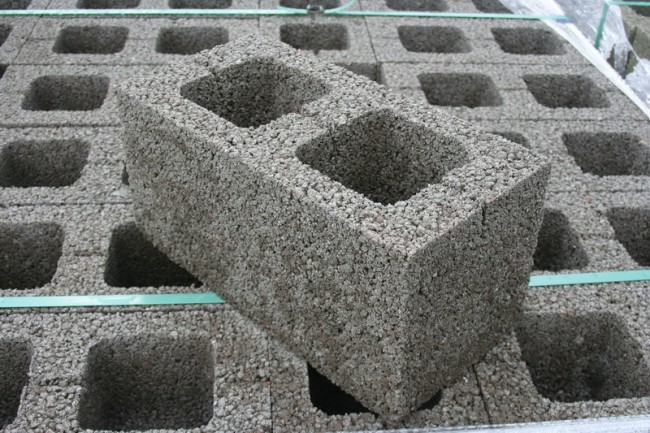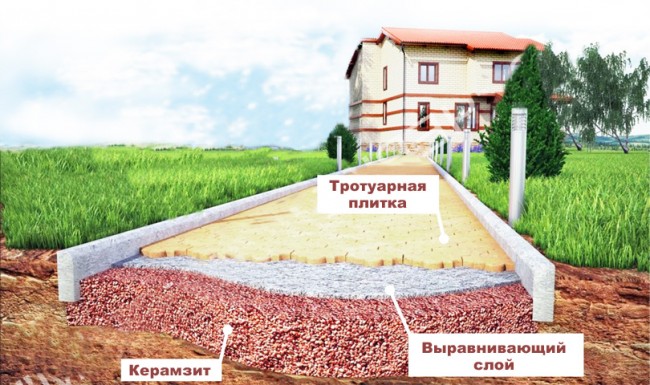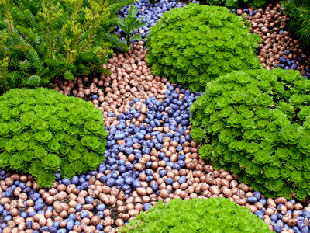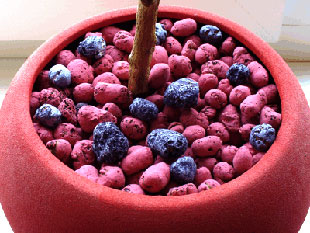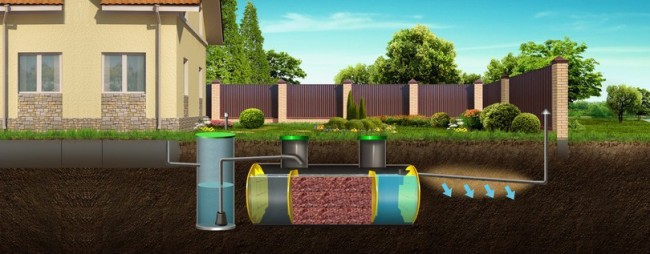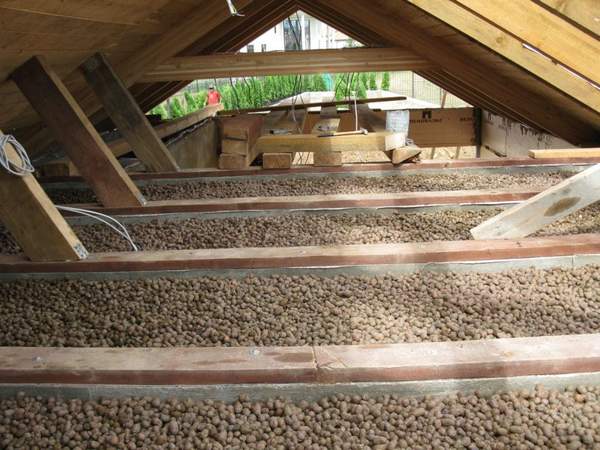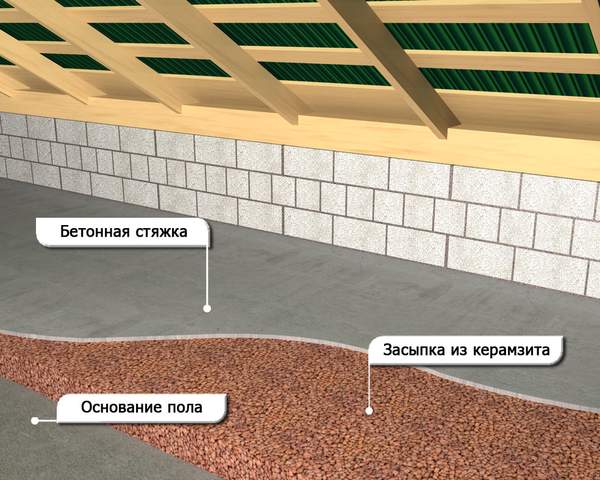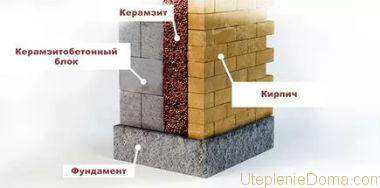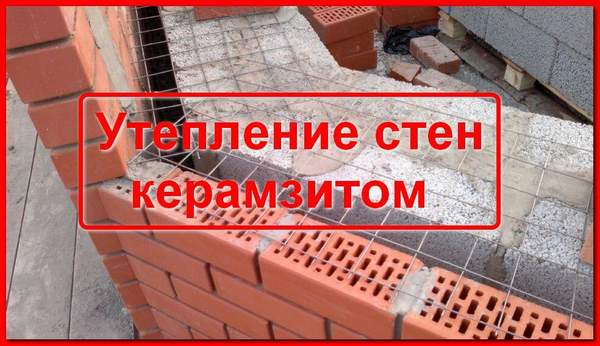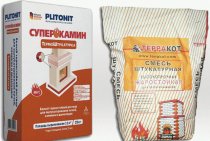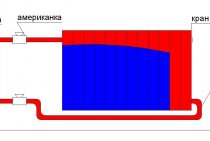Insulation of the ceiling with expanded clay calculation of the layer thickness
Before purchasing material for insulation, you should understand what layer of expanded clay is needed for the room.
The effectiveness of the heat insulator occurs at a minimum level of backfill to a depth of 40 cm, if the house is wooden. For concrete floors, a layer of expanded clay is allowed at least 30 cm.
The procedure for insulating the ceiling with expanded clay material consists of the following steps:
- The old insulation is dismantled (if any) and the base is cleaned of debris and other contamination.
- Installed waterproofing film. The PVC film is overlapped on the adjacent edge of the material and on the wall with an allowance of 15-20 cm. The joints are fixed with construction tape.
- The heat-insulating material is poured - first a layer of fine fraction, then a large one and the final layer is also fine granulate.
- The screed is poured.
When calculating the thickness of the heat insulator layer, the loads exerted on the ceiling are taken into account. The efficiency of heat storage and the bearing capacity of floors depend on accurate calculations. After this parameter is identified, the volume of the material expended is calculated.
The standard consumption is calculated according to the following principle: a layer thickness of 1 cm is distributed over 0.01 m³, i.e. per square meter. If the insulator needs to be calculated based on liters, then it looks like this - 1 cm of insulation is equal to 10 liters. per 1 m². As a result, the total surface area of the ceiling is multiplied by the calculated material consumption per 1 m².
Calculation formula: S x R \u003d V, where S is the area, R is the consumption of insulation per 1 m², V is the total volume of material.
Comfortable living in a private house determines the conduct of insulation work. At the same time, the higher the thickness of expanded clay, the better the efficiency of expanded clay. Choosing eco-friendly materials, correctly calculating the layer thickness and acting according to the instructions, you can get an excellent result in the form of an optimal climate in the rooms.
Expanded clay wall insulation technology
One of the popular ways to insulate walls with expanded clay involves the creation of a three-layer frame of the house. The main (inner) part with a thickness of 40 cm or more is made of expanded clay concrete elements of various sizes - a durable building material with a high degree of thermal insulation. Due to its composition, expanded clay concrete also received high strength, which allows it to be used instead of conventional bricks, foam and aerated concrete.
Expanded clay acts as a second layer as a wall insulation - it is mixed with cement, obtaining a mixture called capsicement. The composition includes 1 part of the cement mixture and 10 times more expanded clay. The hardened mixture allows you to get a structure that is both rigid and reduces the heat loss of the building to a minimum. A small mass of hardened capsicement practically does not increase the load on the foundation of the house and does not require its strengthening.
The last, outer layer is designed to protect the insulation and improve the aesthetic characteristics of the building. Usually it is made of clinker bricks, wood or "lining". Fiber cement boards, granite and aluminum panels can be used for this.
Other ways to use the material
In addition to the commonly used 3-layer option, other methods are used in the construction of private houses. One of them, a lightweight well, involves the following steps:
- the construction of two brick walls located parallel to each other, the thickness of which reaches 1/2 brick, and the distance is 140–340 mm;
- creation of special jumpers across the walls - the distance between them should be 600–1200 m;
- falling asleep in the formed cavities of expanded clay, its ramming and adding "cement milk" every half a meter in height.
The technique differs from the popular method by the presence of jumpers, a different composition of the aggregate and walls. The next option provides for almost the same actions - from creating parallel brick enclosing structures to laying expanded clay granules as an insulating layer. The differences lie in the use of special embedded elements made of reinforcing brackets or fiberglass.
All the options described above can be used in conjunction with any other materials for the walls of a private house. They are also used in houses built of foam concrete or aerated concrete. In this case, the distance between the walls decreases to 100 mm - taking into account the low thermal conductivity of such blocks, the expanded clay thickness can be reduced. The compaction of the layer of expanded clay granules is carried out gradually, tamping and pouring cement every 500 mm in height. The arrangement of ventilation gaps helps to increase the reliability of the walls and preserve them from excess moisture.
Insulation of wooden structures
Insulation with expanded clay wooden walls leads to a number of difficulties. Usually the tree is protected by mineral wool boards with a thickness of 100–150 mm; when choosing expanded clay granules, this figure will have to be increased by 3–4 times. The weight of a 400 mm layer is too large for a conventional log house, so an additional foundation is arranged on the outside.
Additional costs for the construction of the foundation of the house lead to an increase in the cost of the entire project.
For this reason, wood insulation with expanded clay is unpopular in cold regions of the country. It is much more efficient and profitable to use mineral wool. In addition, the right thickness of the log house sometimes allows you to do without insulation.
Alternative materials
To date, making drainage for flowers with your own hands is quite simple. To do this, it is enough to use improvised materials that can be found in any home:
- aquarium rock. Such stones are considered a good alternative, but they are quite expensive. But if such material is available, then it must be used.
- Gravel and rubble. Soil drainage with such material is considered a very common solution. The only drawback is that such elements significantly increase the weight of the pot. Gravel and crushed stone are especially appropriate if they will be used for small containers that do not need to be moved often.
- Broken brick. This is one of the most budget options. Such material is considered natural, due to which it only benefits the plant. But before sending brick particles into a pot for color, they must be sharpened so that the sharp edges do not injure the root system of the plant. Separately, it is worth considering that white brick is most suitable for drainage than red.
- Styrofoam. This material perfectly replaces the elements familiar to everyone. But, you can’t crumble it: the foam must be cut into small cubes, which are evenly placed in a pot. The only negative can be attributed only to the fact that the root system often braids such drainage material, which is why it is then injured.
When choosing the most suitable drainage for indoor plants, you need to remember that it must be safe for the plant itself. Only in this case, the flower will develop rapidly, delighting with its beauty and freshness.
https://youtube.com/watch?v=REUAmx3LIEI
Applications of expanded clay in the suburban area
As mentioned earlier, expanded clay can participate both in construction work and in landscape design, we will consider everything in order.
Expanded clay is most actively used as an inexpensive insulation for floors, basements, ceilings and walls. When insulating the roof and floor, you will not only create high-quality thermal insulation, but also provide the room with good sound insulation. Expanded clay pillow retains heat well and because.it is light in weight, will not create large loads on the structure of the building.
Applications of expanded clay for floor insulation
Expanded clay applications for wall insulation
With regard to public utilities, recently expanded clay plays an important role here. As a result of a pipeline break, it is necessary to dig out the soil at the accident site for further repair, which is very difficult. The most common cause of an accident is the freezing of water in the pipe, as a result of which the pipe breaks. As mentioned earlier, expanded clay has good thermal insulation properties, so if they fill up a water channel that runs underground, the chance of pipes freezing is significantly reduced.
It is also advisable to use expanded clay to create various types of foundation. Unlike gravel, expanded clay is light in weight and has fairly good strength, which means that the foundation will be able to withstand the same loads, while transporting building materials will be easier and less expensive. It should be noted that due to its thermal insulation properties, the foundation with the addition of expanded clay can be laid to a shallower depth.
In addition to creating a concrete solution, expanded clay is used in construction to create expanded clay blocks that are light in weight and have good strength and thermal insulation. With the help of expanded clay blocks, you can build both internal and external walls of the building.
Expanded clay block
Another area of expanded clay application is road construction. When a road is built on wetlands or on soil with a high aquifer, expanded clay bedding is often used, which quickly removes excess water and prevents road flooding.
Expanded clay pillow for roads
A drainage cushion made of expanded clay drains water well, so often such a cushion is made under the foundation, as well as borders.
Expanded clay also occupied an important purpose in the landscape design of the backyard territory. Due to its decorative appearance, expanded clay gravel is often used to decorate garden terraces and luxurious alpine slides built on hilly areas.
Expanded clay in landscape design
In horticulture, expanded clay is used as a good insulation, as well as drainage for plant roots. Very often expanded clay is added to a container with plants grown in hydroponics, which, unlike soil, reduces the risk of plant diseases, as well as the appearance of various pests.
If expanded clay is added to fertile soil, then the yield will increase, and by an order of magnitude. Expanded clay can be added in 2 ways:
- When planting trees and shrubs, a hole is created, an expanded clay pillow is poured onto its bottom, soil is poured over it. We place the root system of the plant on the ground, which we sprinkle a little with soil and fill the remaining space, again, with expanded clay. The resulting "soil-expanded clay cake" will well saturate the root system with nutrients and water.
- An easier way is to mix a fine fraction of expanded clay with soil for further pouring the mixture into the hole with the plant placed.
Both the first and the second methods increase the fertility of the plant at minimal cost to improve the soil.
The advantage of expanded clay, which is added to the soil with plants, is that the water saturation of plants increases, air exchange improves, and the roots are also protected from drying out in hot weather and mold formation in rainy weather.
Expanded clay can also be used to increase the fertility of indoor plants. To do this, expanded clay of a fine fraction is added to a plant grown in a hydroponic pot.
Expanded clay for indoor plants
Well, the last, important area of application of expanded clay in a summer cottage is that the expanded clay pillow serves as a good filter, so if a layer of expanded clay is poured at the bottom of the treatment plant, the liquid will quickly separate from solid waste.
expanded clay pillow serves as a good filter
As you can see, expanded clay has a lot of advantages and a wide range of applications, both in the construction business, and in gardening, and even in landscape design, so it makes sense to purchase
The functional purpose of the holes in the pot
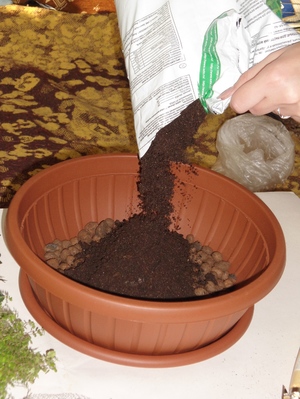
The main difficulties can arise when using ceramic products, since they contain only one hole, but for some types of flowers this is quite enough. But plastic pots are produced completely without holes. In this case, all holes must be pierced by yourself.
Experts distinguish between fast and moderate types of drainage. For succulents, age-old cacti, and delicate orchids, a compact pot with small holes is best. For filling, you can use the substrate and coarse sand, crushed brick or other components that will help to quickly remove excess water. Separately, it should be noted that for plants that prefer moist soil, it is best to choose pots with a small number of holes, as well as a dense substrate.
Despite the number of drainage holes and their size, they should always be controlled so that they do not become clogged with soil and root processes. Using larger pebbles will help prevent clogging. If immediately after watering a large amount of water has accumulated in the pan, this means that the holes perfectly fulfill their main function.
When there is very little or no water at all, it means that the drain holes are completely clogged. In this case, you need to carefully put the pot on its side and clean everything with a regular stick. If this situation is repeated regularly, then the flower is best transplanted into a new container to prevent possible rotting of the root system.
Those plants whose roots grow strongly and can fill the entire space of the pot deserve special attention. In this case, the drainage layer may be completely absent or it must be very thin. The advantage is that the root system will be visible through large holes, so you can quickly assess its condition. It is worth noting that instead of the usual drainage, you can use pebbles, which you need to fill the tray of the flower pot.
The main aspects of ceiling insulation with expanded clay
Expanded clay, as a heater, is a traditional clay. This material is subjected to high-temperature processing with the subsequent formation of granules of the middle fraction. Thermal insulation properties are provided by the porous structure of the material.
The heat insulator layer for heat retention work must be thick to provide an effective cushion. Despite the large weight of the granules, the load on the building is insignificant if the thickness is 50-70 cm.
Experts recommend using expanded clay of different fractions to improve heat-saving characteristics. At the same time, 60-70% of the layer is diverted to coarse gravel. Fine granules are distributed into the upper and lower layers.
Thermal insulation work on the insulation of expanded clay solve such problems as:
- Expanded clay has soundproofing properties. In view of this, with the help of a heat insulator, it ensures the safety of silence from both the sounds of precipitation and noise from the street.
- At sub-zero temperatures, heat remains in the house, because. heated air is not able to leave the premises due to the lack of cold bridges. Provided that the insulation work is carried out correctly.
- At high temperatures, expanded clay prevents heat from entering the room. Thus, the effect of a thermos is created.
Useful video
In the video, let's see an example of warming the ceiling of an extension of a private wooden house with expanded clay backfill:
You can cope with this work yourself at some stages of the preparatory work. Laying engineering networks: ventilation, electrical wiring, plumbing - trust the builders who perform a range of construction and installation works.
(2 ratings, average: 5.00 out of 5)
- Features of thermal insulation
- Advantages and disadvantages
- Warming technology
- Preparatory work
- Installation instructions
- Surface finish
Expanded clay ceiling insulation is a great alternative to using traditional heat insulators like foam or mineral wool. It makes it possible to provide high-quality heat saving in any type of room. In addition, this method does not require significant costs.
Accessories
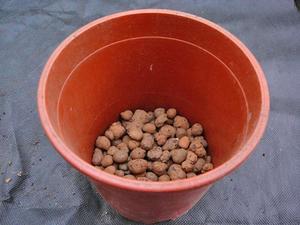
- Gently heat an iron object (for example, a thick nail, awl or knife) over a fire and make all the necessary holes for it.
- Using a conventional drill, drill holes of the required diameter.
Wall insulation with expanded clay in frame and brick houses
One of the ways to insulate a stone wall with expanded clay.
Usually skeletons are insulated with lightweight materials with a low coefficient of thermal conductivity. These include mineral wool, polystyrene foam, liquid polyurethane foam and penoizol. The use of loose thermal insulation is extremely rare. The motivation for wall insulation with expanded clay can be its low cost. When installing, you need to take into account the technical features of this material:
- high density;
- high thermal conductivity;
- low moisture absorption along with very low moisture return.
Expanded clay as a wall insulation is too heavy, its density reaches 500 kg / m. cube, although it may be slightly less than 250 kg / m. cube
In any case, even the minimum density of the material creates a serious load on the walls.
Therefore, in addition to a more durable frame made of a larger section of timber, special attention should be paid to the internal and external rough finish of the frame, which will hold the weight of the thermal insulation.
Expanded clay retains heat three times worse than mineral wool or polystyrene. The coefficient is a modest 0.1-0.18 W / m * K, so a layer three times thicker than modern materials will be required. In addition, expanded clay, practically not absorbing moisture, nevertheless gradually accumulates it in its structure. At the same time, it practically does not remove water, and it is not easy to dry it. To prevent this undesirable process, when insulating walls with expanded clay according to technology, it is necessary to lay vapor barrier and waterproofing.
It is necessary to keep steam not only because it can be absorbed into expanded clay. This material is non-monolithic, air gaps remain between the fractions, through which air passes unhindered. In winter, because of this, it can even form frost on the walls of the house. The method of warming frame walls with expanded clay:
- an inner wall that holds thermal insulation;
- vapor barrier with glued joints so that an airtight layer is formed;
- expanded clay;
- diffusion membrane (waterproofing);
- outer wall.
When choosing how to make the heating of the cottage gas or solid fuel, we recommend that you still lean towards natural gas. This brings a lot of benefits.
Read more about what is the cheapest way to heat your home.
Insulation of a brick wall with expanded clay can be carried out both during the construction of the house and at the end of the work. In the first case, expanded clay is poured between the inner and outer walls as soon as the enclosing structure is ready. In the second case, you will need to build an additional outer wall in one brick. For it, you need to pour a separate foundation. Expanded clay is poured into the inter-wall space.
It is also possible to fix a massive wooden frame on the outside of the house, and sew it up with a shawl. The gap between the shalevka and the brick is filled with thermal insulation. In this case, it is necessary to exclude the contact of expanded clay with the ground by laying a reliable layer of waterproofing (roofing material or bituminous roll materials) or by installing limiters from bars at the required height.
A competent hermetic scheme for heating a one-story house can be developed independently. The main thing is to follow the rules for the selection and placement of equipment.
An interesting article about inverter heating furnaces.
Rules and features of expanded clay wall insulation
Heat loss through the building envelope of a private house is one of the main factors by which heating is calculated. Significant costs for the use of energy carriers (gas, firewood or liquid fuel) can be reduced by wall insulation with expanded clay - a material that is used as a heater because of its durability and affordable price. Almost the only drawback of this option is the increase in construction time.
The advantages of choosing expanded clay as a filler for building envelopes include:
- production from natural materials - a feature that makes the insulation safe and environmentally friendly;
- porosity of the structure, providing a high level of heat and sound insulation;
- resistance to external influences and durability;
- immunity to temperature changes, obtained due to the filling of expanded clay granules with air.
The walls are insulated with expanded clay by usually filling the material, which does not require the use of special technologies and a significant investment of time.
In addition, expanded clay granules have a high fire resistance obtained by firing, and a small mass. The hard shell gives the material additional resistance to moisture, fungus, insects and rodents.
Advantages of expanded clay
No wonder expanded clay has become so popular in the construction business. The most significant advantages of expanded clay are:
- Optimal price/quality ratio
- Low water absorption of the material (no more than 20%)
- High frost resistance (from 25 cycles and more)
- Environmental friendliness of the material (no additives, only burnt shale)
- Good sound and heat insulation properties
- Expanded clay has a light weight
- The material has high strength and durability
- Expanded clay is resistant to acids
As you can see, expanded clay has many advantages, so it is advisable to use it in the construction business, especially if you are building light garden buildings.
As for the field of application of expanded clay, most often these materials are used as a heater, filler for concrete mortar, as well as drainage for plants. Now we will take a closer look at the field of application of expanded clay.
